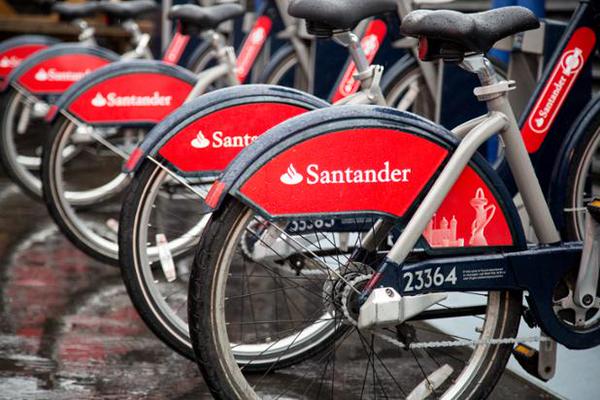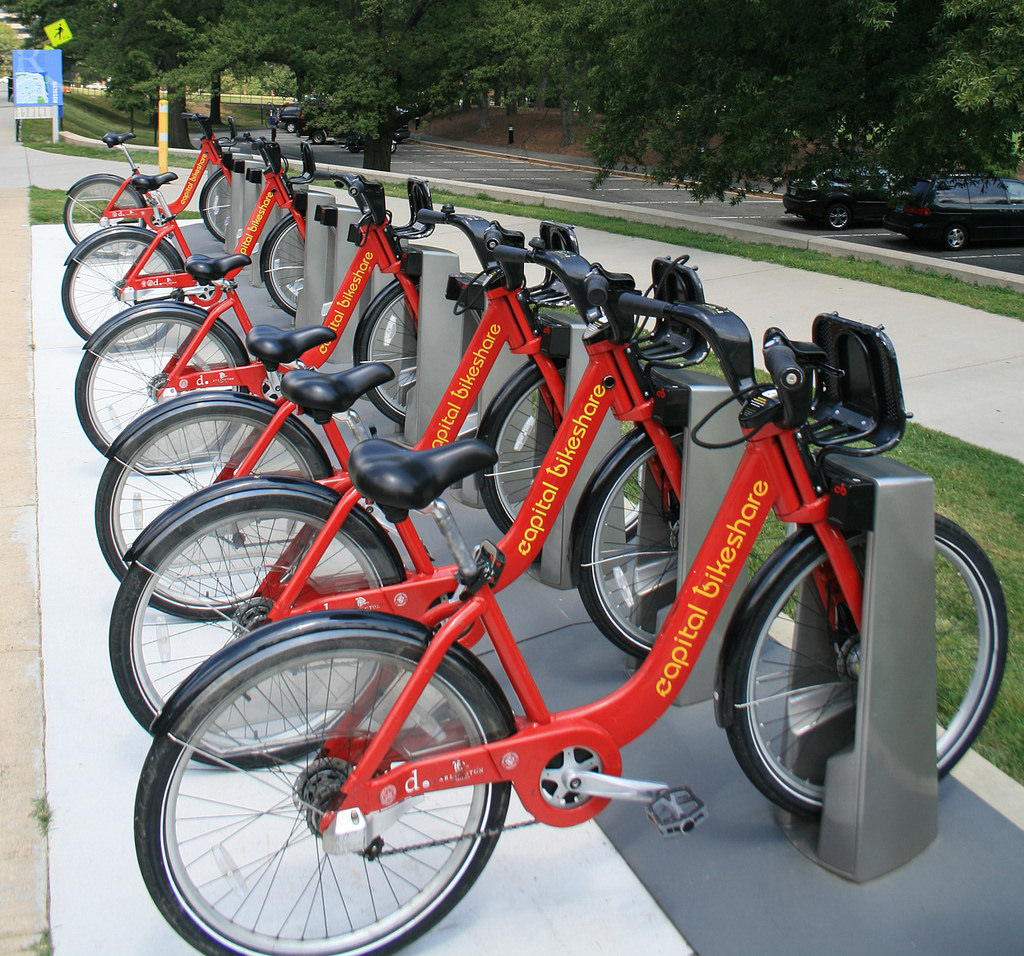
Seeing Red: 15 Ways the Boris Bikes of London Could be Better

I’ll be gradually tweaking this article to add/amend sources, clarifications and develop some of my arguments.
A big announcement for the “Boris Bikes” today, aka Barclays Cycle Hire. London’s bikeshare system, the second largest in the western world after Paris’s Velib and nearly five years old, will be rebranded as Santander Cycles, and the bikes with have a new, bright red branding – Santander’s corporate colour, and conveniently also London’s most famous colour. As well as the Santander logo, it looks like the “Santa Bikes” will have outlines of London’s icons – the above publicity photo showing the Tower of London and the Orbit, while another includes the Shard and Tower Bridge. A nice touch to remind people these are London’s bikes.
It’s great that London’s system can attract “big” sponsors – £7m a year with the new deal – but another document that I spotted today reveals that, despite the sponsorship, London’s system runs at a large operating loss – this is all the more puzzling because other systems can (almost) cover their operating costs – including Washington DC’s which is both similar to London’s in some ways (a good core density, same bike/dock equipment) and different (coverage into the suburbs, rider incentives); and Paris’s, which has a very different funding model, and its own set of advantages (coverage throughout the city) and disadvantages (little incentive to expand/intensify). What are they doing right that London is not?
In financial year 2013/4, London’s bikeshare had operating costs of £24.3m. Over this time period, the maximum number of bikes that were available to hire was 9471, on 26 March 2014. This data comes from TfL’s own Open Data Portal. This represents a cost of over £2500 per bike, for that year alone. If you look at it another way, each bike is typically used three times a day or ~1000 times a way, so that’s about £2.50 a journey, of which the sponsor pays about £1 and the user about £0.50. As operating costs, these don’t include the costs of buying the bikes or building the docking stations. Much of the cost is likely absorbed in repairing the bikes – London’s system is wildly successful, so each bike sees a lot of use every day, and the wear and tear is likely to be considerable. This is not helped by the manufacturers of the bikes going bust a couple of years ago – so there are no “new” ones out there to replace the older ones – New York City, which uses the same bikes, is suffering similar problems. The other big cost will be the rebalancing/redistribution activity, operating a fleet of vehicles that move bikes around.
I have no great issues with the costs of the bikes – they are a public service and the costs are likely a fraction of the costs of maintaining the other public assets of roads, buses, railway lines – but it is frustrating to see that, with the current setup of London’s system, the main beneficiaries are tourists (The Hyde Park docking stations consistently being the most popular), commuters (the docking stations around Waterloo are always popular on weekdays), and those Londoners lucky enough to live in Zone 1 and certain targeted parts of Zone 2 (south-west and east). Wouldn’t be great if all Londoners benefited from the system?
Here’s 15 ways that London’s bikeshare could be made better for Londoners (and indeed for all) – and maybe cheaper to operate too:
- Scrap almost all rebalancing activity. It’s very expensive (trucks, drivers, petrol), and I’m not convinced it is actually helping the system – in fact it might be making it worse. Most cycling flows in London are uni-directional – in to the centre in the morning, back out in the evening – or random (tourist activity). Both of these kinds of flows will, across a day, balance out on their own. Rebalancing disrupts these flows, removing the bikes from where they are needed later in the day (or the following morning) to address a short-term perceived imbalance that might not be real on-the-ground. Plus, when the bikes are in sitting in vans, inevitably clogged in traffic, they are of no use to anyone. Some “lightweight” rebalancing, using cycle couriers and trailer, could help with some specific small-scale “pinch points”, or responding to special events such as heavy rainfall or a sporting/music event. New York uses cyclists/trailers to help with the rebalancing.
- Have a “guaranteed valet” service instead, like in New York. This operates for a certain number of key docking stations at certain times of the day, and guarantees that someone can start or finish their journey there. London already has this, to a certain extent, at some stations near Waterloo, but it would be good to highlight this more and have it at other key destinations. This “static” supply/demand management would be a much better use of the time of redistribution drivers.
- Have “rider rewards“, like in Washington DC. Incentivise users to redistribute the bikes themselves, by allowing a free subsequent day’s credit (or free 60-minute journey extension) for journeys that start at a full docking station and end at an empty one. This would need to be designed with care to ensure “over-rebalancing”, or malicious marking of bikes as broken, was minimised. Everyone values the system in different ways, so some people benefit from a more naturally balanced system and others benefit from lower costs using it.
- Have more flexible user rules. Paris’s Velib has an enhanced membership “Passion” that allows free single journeys of up to 45 minutes rather than every 30 minutes. In London, you have to wait 5 minutes between hires, but most systems (Paris, Boston, New York) don’t have this “timeout” period. To stop people “guarding” bikes for additional use, an alternative could be make it a 10 minute timeout but tie it to the specific docking station (or indeed a specific bike) rather than system-wide.
- Adjust performance metrics. TfL (and the sponsors) measure performance of the system in certain ways, such as the time a docking station remains empty at certain times of the day. I’m not sure that these are helpful – surely the principle metric of value (along with customer service resolution) is the number of journeys per time period and/or number of distinct users per time period. If these numbers go down, over a long period, something’s wrong. The performance metrics, as they stand, maybe encouraging the unnecessary and possibly harmful rebalancing activity, increasing costs with no good gain.
- Remove the density rule (one docking station every ~300 metres) except in Zone 1. Having high density in the centre and low density in the suburbs works well for many systems – e.g. Bordeaux and Washington DC, because it allows the system to be accessible to a much larger population, without flooding huge areas with expensive stations/bikes. An extreme example, this docking station is several miles from its nearest neighbour, in a US city.
- Build a docking station outside EVERY tube station, train station and bus station inside the North/South Circular (roughly, Zones 1-3). Yes, no matter how hilly* the area is, or how little existing cycling culture it has – stop assuming how people use bikes or who uses them! Bikeshare is a “last mile” transport option and it should be thought of as part of someone’s journey across London, and as a life benefit, not as a tourist attraction. The system should also look expand into these areas iteratively rather than having a “big bang” expansion by phases. It’s crazy that most of Hackney and Islington doesn’t have the bikeshare, despite having a very high cycling population. Wouldn’t be great if people without their own bikes could be part of the “cycling cafe culture” strong in these places? For other places that have never had a cycling culture, the addition of a docking station in a prominent space might encourage some there to try cycling for the first time. (*This version of the bikes could be useful.)
- Annual membership (currently £90) should be split into peak and off-peak (no journey starts from 6am-10am) memberships, the former increased to £120 and the latter decreased back to £45. Unlike the buses and trains, which are always full peak and pretty busy off-peak too, there is a big peak/offpeak split in demand for the bikes. Commuters get a really good deal, as it stands. Sure, it costs more than buying a very cheap bike, but actually you aren’t buying the use of a bike – you are buying the free servicing of the bike for a year, and free distribution of “your” bike to another part of central London, if you are going out in the evening. Commuters that use the bikes day-in-day-out should pay more. Utility users who use the bike to get to the shops, are the sorts that should be targetted more, with off-peak membership
- A better online map of availability. The official map still doesn’t have at-a-glance availability. “Rainbow-board” type indications of availability in certain key areas of London would also be very useful. Weekday use, in particular, follows distinct and regular patterns in places.
- Better indication of where the nearest bikes/docks are, if you are at a full/empty docking station, i.e. a map with route indication to several docking stations nearby with availability.
- Better static signage of your nearest docking station. I see very few street signs pointing to the local docking station, even though they are hard-built into the ground and so generally are pretty permanent features.
- Move more services online, have a smaller help centre. A better view of journeys done (a personal map of journeys would be nice) and the ability to question overpayments/charges online.
- Encourage innovative use of the bikeshare data, via online competitions – e.g. Boston’s Hubway data visualisation competitions have had lots of great entries. These get further groups interested in the system and ways to improve it, and can produce great visuals to allow the operator/owner to demonstrate the reach and power of the system.
- Allow use of the system with contactless payment cards, and so integration with travelcards, daily TfL transport price caps etc. The system can’t use Oyster cards because of the need to have an ability to take a “block payment” charge for non-return of the bikes. But with contactless payment, this could be achieved. The cost of upgrading the docking points to take cards would be high, but such docking points are available and in use in many of the newer US systems that use the same technology.
- Requirement that all new housing developments above a certain size, in say Zone 1-3 London, including a docking station with at least one docking point per 20 residents and one new bike per 40 residents, either on their site or within 300m of their development boundary. (Update: Euan Mills mentions this is already is the case, within the current area. To clarify, I would like to see this beyond the current area, allowing an organic growth outwards and linking with the sparser tube station sites of point 7.)
London has got much right – it “went big” which is expensive but the only way to have a genuinely successful system that sees tens of thousands of journeys on most days. It also used a high-quality, rugged system that can (now) cope with the usage – again, an expensive option but absolutely necessary for it to work in the long term. It has also made much data available on the system, allowing for interesting research and increasing transparency. But it could be so much better still.

Washington DC’s systems – like London’s but profitable.
